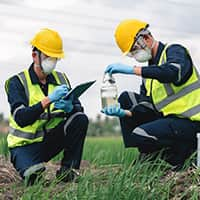Glossary of Environmental Health and Safety Terms
Written by Staff Writer

Asbestos Abatement: The safe removal, containment or sealing of asbestos to prevent the release of harmful fibers into the air.
Behavior-Based Safety (BBS): A strategy that focuses on improving workplace safety by encouraging and reinforcing safe behaviors through observation and feedback.
Biological Hazard (Biohazard): A risk posed by living organisms or substances produced by them. Examples include viruses, bacteria and toxins that can cause infections or illnesses in humans and animals.
Chemical Safety: The practice of managing and handling chemicals responsibly to prevent accidents, injuries and environmental harm.
Compliance Audit: A systematic review conducted to ensure that an organization adheres to safety, environmental and legal regulations and standards.
Environmental Management System (EMS): A structured plan that businesses use to monitor and reduce their environmental impacts. An EMS includes goals like cutting emissions, reducing waste and conserving energy.
Environmental Health and Safety (EHS): Measures or policies that organizations use to manage potential risks to people and the environment.
Exposure Assessment: The process of evaluating the extent and duration of exposure to harmful substances or conditions to determine risks to health and safety.
Exposure Limit: The maximum amount of a harmful substance that a person can be exposed to without significant risk of injury.
Fall Protection: Safety systems and practices, such as harnesses, guardrails and training, aimed at preventing falls from heights and reducing the risk of injury in workplaces like construction sites or warehouses.
Fire Safety: Practices, measures and equipment, such as fire extinguishers, alarms and evacuation plans, aimed at preventing fires and ensuring safe responses in case of an emergency.
Hearing Conservation: Programs and practices designed to protect workers from hearing loss caused by excessive noise exposure, including monitoring noise levels and providing ear protection. These programs often include regular hearing tests and training so that employees understand the risks and how to use protective equipment.
Industrial Hygiene: The science of anticipating, recognizing and controlling workplace conditions that may harm workers' health. This includes monitoring air quality, noise levels and chemical exposures.
Landfill: A site where waste is buried. Landfills are typically built with protective liners and systems to prevent environmental contamination.
Lead Poisoning: A serious health condition caused by exposure to lead, often found in old paint or contaminated water. It can cause developmental delays, especially in children.
Lockout/Tagout (LOTO): A safety procedure that ensures that machinery is properly shut down and cannot be restarted during maintenance or repairs, preventing accidental injuries. It uses locks and tags to secure energy sources so that only authorized personnel can remove them once work is complete.
Noise Monitoring: The measurement and assessment of sound levels in a workplace to identify risks of hearing damage and implement controls to reduce exposure.
Occupational Health: A field focused on protecting workers' health by identifying and managing hazards in the workplace, such as excessive noise, toxic chemicals or repetitive motions.
Particulate Matter (PM): Tiny particles or droplets in the air, such as dust or soot, that can be inhaled and cause respiratory and cardiovascular problems.
Personal Protective Equipment (PPE): Specialized clothing or gear, such as gloves, helmets and goggles, worn to protect individuals from workplace hazards and injuries.
Safety Data Sheet (SDS): A document that provides information about a chemical's hazards, safe handling, storage and emergency measures.
Spill Prevention Control and Countermeasure (SPCC): A regulatory plan designed to prevent, control and respond to oil spills that could harm waterways or the environment, focusing on proper storage, handling and emergency measures.
Toxic Release Inventory (TRI): A publicly available database that tracks the release of hazardous chemicals by industries to help communities understand and reduce environmental risks. It requires facilities to report annually on their chemical use, releases and waste management practices, promoting transparency and accountability.
Toxic Substance: Any chemical or material that can cause harm to humans, animals or the environment. Proper handling and disposal are essential to prevent exposure.
Ventilation: The process of exchanging indoor air with fresh outdoor air to reduce pollutants, moisture and heat.
More Resources
- Basic Workplace Safety Rules
- Environmental Health and Safety General Guidelines
- Top Ten Serious OSHA Violations
- Environmental Health Hazards
- Types of Environmental Hazards
- Workplace Safety Training
- Improving Environmental Health in Schools
- Managing Hazardous Waste in the Workplace
- Environmental Health and Its Importance
- Learn to Avoid Health and Safety Risks on the Job
